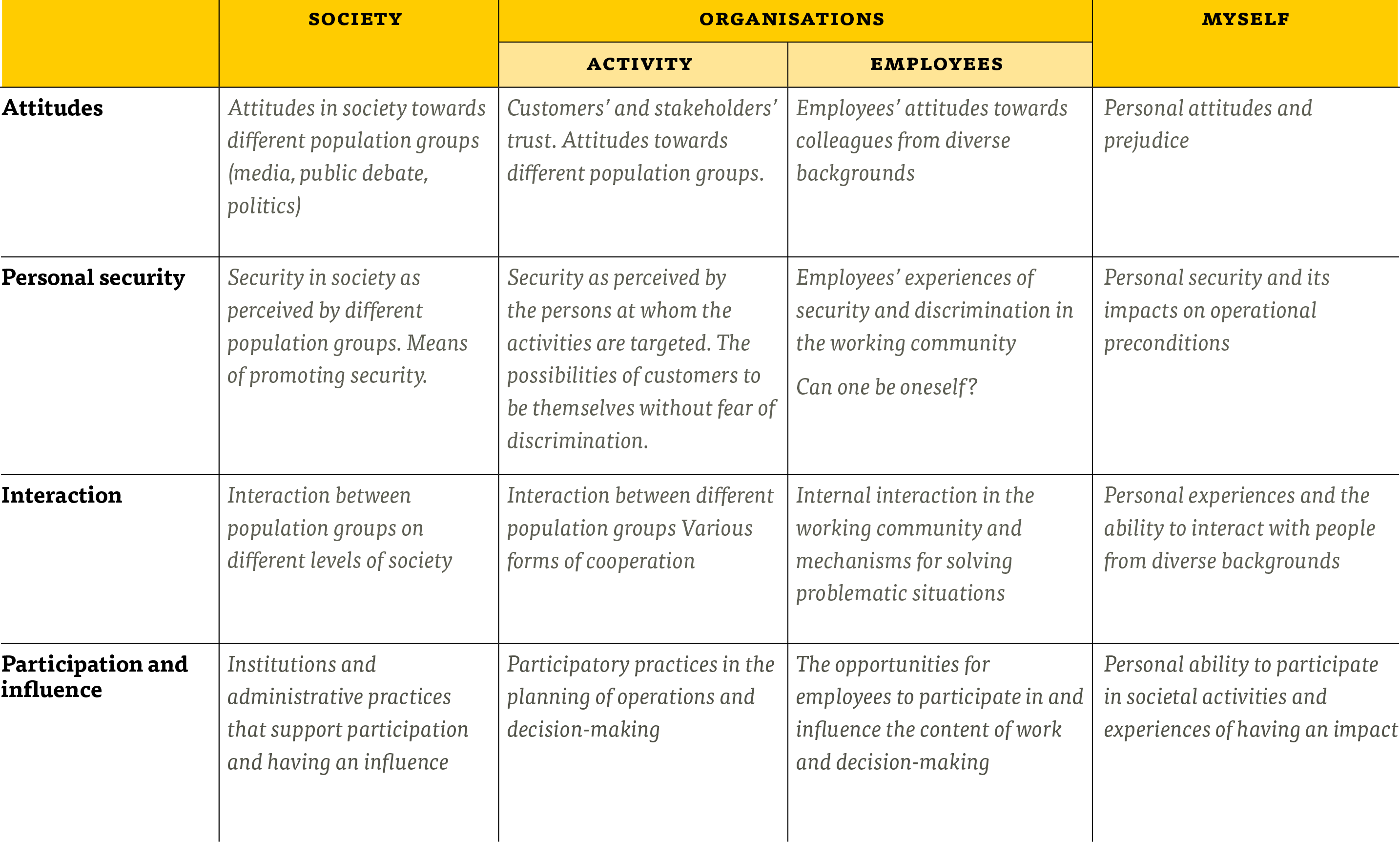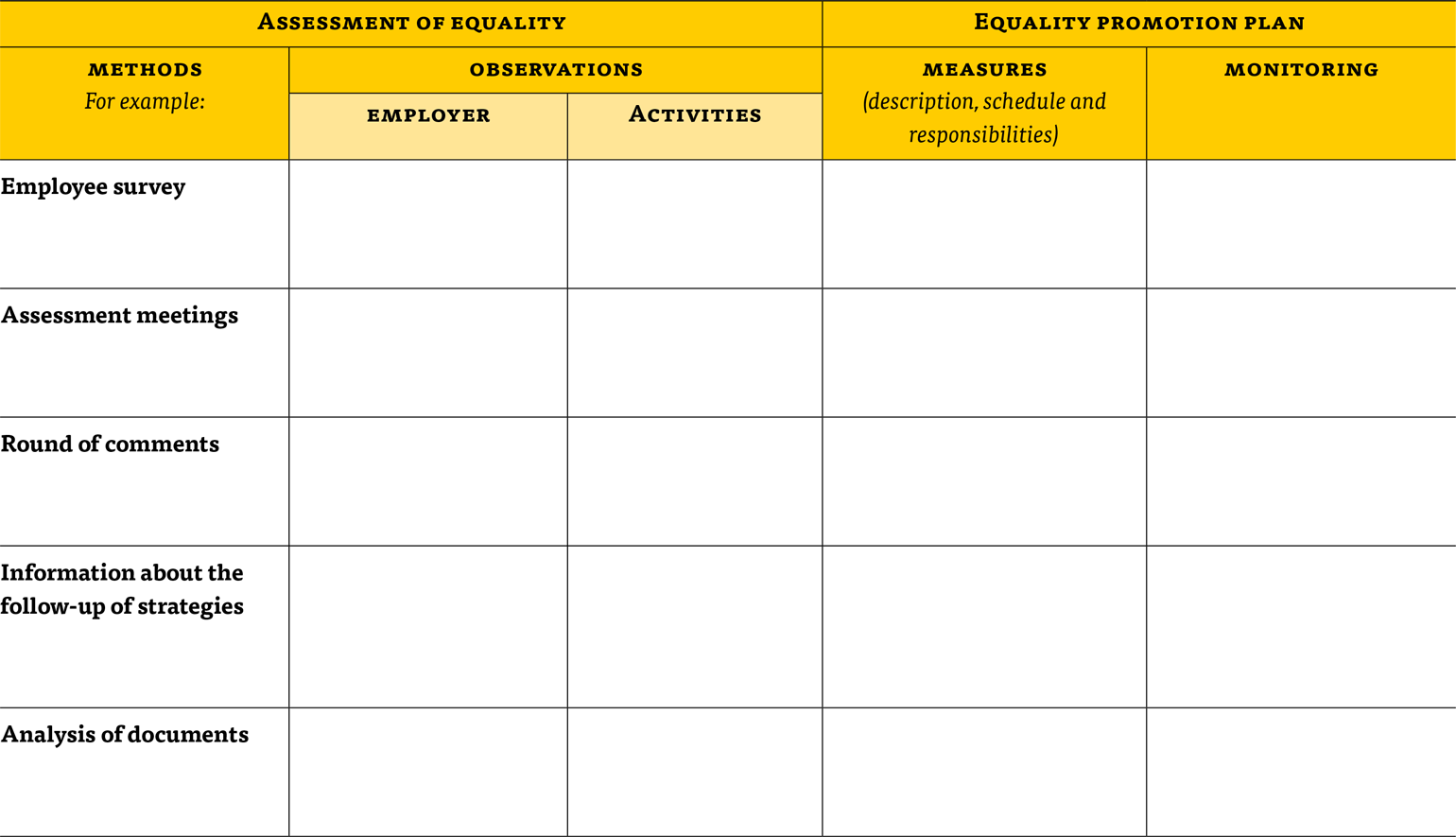
Assessment of equality
Tool for the assessment of equality
The new Non-Discrimination Act entered into force on 1 January 2015. The purpose of the Act is to foster equality and prevent discrimination, as well as enhancing the legal protection of those who have been discriminated against. The act includes provisions on the obligation of various actors to assess and promote equality with respect to staff and other activities.
Assessment of equality
Why?
 The new Non-Discrimination Act entered into force on 1 January 2015. The purpose of the Act is to foster equality and prevent discrimination, as well as enhancing the legal protection of those who have been discriminated against. The act includes provisions on the obligation of various actors to assess and promote equality with respect to staff and other activities.
The new Non-Discrimination Act entered into force on 1 January 2015. The purpose of the Act is to foster equality and prevent discrimination, as well as enhancing the legal protection of those who have been discriminated against. The act includes provisions on the obligation of various actors to assess and promote equality with respect to staff and other activities.
The equality assessment tool is intended to serve as an aid for actors engaged in promoting equality. It includes
1) information on the contents of the Non-Discrimination Act
2) suggestions for assessment criteria for use by various actors when assessing equality
3) examples of issues related to various groups facing the risk of discrimination
4) examples of the development of organisational activities from the perspective of non-discrimination
4) examples of methods for assessing equality
5) and tips on how to proceed from assessment to preparing and implementing an equality promotion plan.
What are the benefits of assessing and promoting equality?
The purpose of assessing equality is to identify discrimination and find methods of improving equality in the workplace and in various activities. The assessment provides a basis for authorities, the training provider and employers enabling them to implement efficient measures for preventing and intervening in cases of discrimination and promoting the equality of various groups. Systematic promotion of equality promotes the equal opportunities of all employees and service users to participate and influence activities. It prevents discrimination in advance, improves internal interaction within organisations, enhances safety and helps organisations to benefit from diversity. Promotion of equality improves not only the social atmosphere, but also the efficiency and productivity of work, while promoting social justice on a broader scale. Every workplace that promotes equality represents a step towards achieving a non-discriminating Finland.
Whom does the obligation to assess apply to?
 Are you
Are you
1) An authority?
In this Act, an authority means central and local government authorities, independent bodies governed by public law and parliamentary agencies, as well as authorities in the province of Åland when the latter discharge provisions pertaining to national legislation. The provisions on an authority also apply to other instances of discharging a public administrative function.
2) Education provider
In this Act, an education provider means the party that provides statutory education or training.
3) or an employer?
In this Act, an employer means the party that employs persons in an employment relationship or service relationship under public law. The provisions of this Act on an employer shall also apply to a user enterprise, referred to in section 7, chapter 1 of the Employment Contracts Act (55/2001) and in section 8, chapter 1 of the Seafarers’ Employment Contracts Act (756/2011) when it exercises the right to direct and supervise temporary agency workers as well to be as a provider of work experience placements and other similar activities insofar as they exercise the right to direct and supervise.
Assessment of equality in the Non-Discrimination Act
Pursuant to the Non-Discrimination Act, the obligations to promote equality apply to authorities, education providers and employers.
Authority
Pursuant to section 5 of the Non-Discrimination Act, the authorities shall evaluate the realisation of equality in their activities and take measures considered necessary to fostering the realisation of equality. Such measures shall be effective, expedient and proportionate, taking into account the authorities’ operating environment, resources and other circumstances. The authorities must have a plan of the necessary measures for the fostering of equality. The obligation to draw up a plan does not apply to the Evangelical Lutheran Church, the Orthodox Church or an individual actor which discharges public administrative functions and regularly employs fewer than 30 persons.
Pursuant to the Non-Discrimination Act, the authorities are obliged to prepare an equality promotion plan both from the perspectives of government activities and the employer (actions and HR policy). The plan should include an assessment of the equality situation, a description of the methods used in assessment, and concrete measures for promoting equality in government activities and at the workplace.
Education provider
Pursuant to section 6 of the Non-Discrimination Act, the education provider and the educational institution maintained by it shall evaluate the realisation of equality in its activities and take any measures considered necessary to fostering the realisation of equality. Such measures shall be effective, expedient and proportionate, taking into account the educational institution’s operating environment, resources and other circumstances. The education provider must ensure that the educational institution has a plan for the measures necessary to fostering equality.
The education provider and the educational institution maintained by it must reserve an opportunity for pupils and their guardians as well as students or their representatives to be heard on the fostering measures.
The education provider is also obliged to assess equality from the employer’s perspective.
Employer
Pursuant to section 7 of the Non-Discrimination Act, an employer must assess the realisation of equality in the workplace and, while taking into account the needs of the workplace, develop the working conditions as well as the methods complied with in the selection of personnel and in making decisions concerning personnel. Such measures shall be effective, expedient and proportionate, taking into account the operating environment, resources and other circumstances.
An employer who regularly employs at least 30 persons must have a plan for measures considered necessary to the promotion of equality. Such measures and their effectiveness must be discussed with the personnel or their representatives.
A shop steward elected on the basis of a collective agreement or a collective agreement for central government, or if one has not been elected, an elected representative as referred to in the Employment Contracts Act, or another representative of the personnel who participated in the planning of non-discrimination measures, has a right to access information, on request, on what actions the employer has taken to foster equality in the workplace. The occupational safety delegate has the same right.
What is assessed?
 The contents of the Non-Discrimination Act are related to the promotion of equality (Chapter 2), prohibitions of discrimination (Chapter 3) and the legal rights of victims of discrimination.
The contents of the Non-Discrimination Act are related to the promotion of equality (Chapter 2), prohibitions of discrimination (Chapter 3) and the legal rights of victims of discrimination.
The contents of the assessment of equality may be divided into two sectors:
1) Identifying discrimination and intervening with it
2) Fostering equality.
Identifying discrimination and intervening with it
One of the key objectives of the Non-Discrimination Act is to prevent discrimination. Identifying discrimination is a key element of assessing equality. When conducting an assessment, you should be aware of the following: what does discrimination in various forms mean according to the Non-Discrimination Act, what is prohibited discrimination and what is legally permissible different treatment, what does positive discrimination mean, what does reasonable accommodation mean and what kinds of discrimination do various population groups encounter.
Under the Non-Discrimination Act, nobody may be discriminated against on the basis of their age, origin, nationality, language, religion, beliefs, opinions, political activity, trade union activity, family relationships, state of health, disabilities, sexual orientation or other personal characteristics. Discrimination is prohibited, regardless of whether it is based on a fact or assumption concerning the person him/herself or another. In addition to direct and indirect discrimination, harassment, denial of reasonable adjustments as well as an instruction or order to discriminate constitute discrimination as referred to in the Non-Discrimination Act.
The evaluation of discrimination may target both HR policy and activities. The assessment may, for instance, seek answers to the following questions:
- Does discrimination in various forms occur in the organisation or in its services?
- How has the discrimination been observed?
- Which groups face discrimination?
- What kinds of procedures are applied to intervening in cases of discrimination?
- How efficient are they?
- What kinds of other measures are applied to the prevention of discrimination? (influencing attitudes etc.)
- What kind of information on discrimination is available in the organisation’s line of business?
- Are persons with disabilities provided with appropriate and reasonable accommodation?
- Is non-discrimination taken into account in job advertisements?
The Non-Discrimination Act also defines permissible different treatment. According to the Act, not all different treatment based on a personal characteristic, such as state of health, age, citizenship or the equivalent, constitutes discrimination. Pursuant to section 11 of the Non-Discrimination Act, different treatment does not constitute discrimination if the treatment is based on legislation and otherwise has an acceptable objective and the measures taken to attain the objective are proportionate. For example, legislation on tobacco, alcohol and traffic contains provisions on different age limits and requirements.
Even different treatment which is not based on legislation may have an acceptable objective with regard to fundamental and human rights. For instance, measures preventing the social exclusion of young people, promoting the equality of language groups or subsidies granted to religious minorities do not constitute discrimination because they strive towards a goal which is acceptable from the perspective of fundamental rights. Such goals may include the promotion of linguistic and cultural rights, non-discrimination, equality, and the rights of children and minorities.
According to section 9 of the Non-Discrimination Act, positive discrimination that aims de facto promote equality, or to prevent or eliminate the disadvantages attributable to discrimination, does not constitute discrimination. Positive discrimination must have an acceptable objective in terms of fundamental and human rights, and must be planned, proportionate and temporary. Positive discrimination includes, for instance, recruitment measures aimed at increasing the proportion of persons belonging to a disadvantaged group (such as immigrants). Positive discrimination may not, however, constitute discrimination against other persons.
Pursuant to section 12 of the Non-Discrimination Act, different treatment at work and in employing personnel is justified if the treatment is founded on genuine and determining requirements concerning the type of occupational tasks in question and their performance, and the treatment is proportionate to achieving the legitimate objective. When hiring a priest, for example, it is permissible to require membership in a certain church, or workers with a Chinese background may be sought for a Chinese restaurant.
In the Non-discrimination Act, discrimination is defined as follows:
| Direct discrimination (section 10): a person is treated less favourably than another person was treated, is treated or would be treated in a comparable situation. |
An entrepreneur refuses to allow a disabled person enter their business premises. |
| Indirect discrimination (section 13): an apparently neutral rule, criterion or practice puts a person at a disadvantage compared with others on the grounds of personal characteristics. |
An employer demands that job applicants have a perfect command of the Finnish language, even though this is not necessary for the performance of the duties in question. |
| Harassment (section 14): Behaviour that is a deliberate or de facto infringement of the dignity of a person, creating a degrading or humiliating, intimidating, hostile or offensive environment for that person. |
Examples of harassment include racist jokes made with the intention of insulting someone or calling a fellow worker, who is a member of a sexual minority, names. |
| Instruction or order to discriminate (section 8): Advisories, directives or requirements that are tantamount to discrimination or foster discrimination. |
A manager at a restaurant orders the doormen to make sure that persons belonging to certain population groups cannot enter the restaurant. |
| Denial of reasonable adjustments (section 15): An authority, education provider, employer or provider of goods and services who fails to make due and appropriate adjustments necessary in each situation for a person with disabilities to secure the non-discrimination of disabled persons is guilty of discrimination. |
An employer refuses to make reasonable adjustments necessary which a disabled job applicant would need to attend a job interview. |
| Prohibition of discriminatory work advertisements (section 17): When advertising an open position, public service office or post, an employer may not unlawfully request information on the personal characteristics or qualities referred to in this Act from applicants. |
A bus company requires Finnish citizenship from applicants in a job advertisement for the position of a bus driver. |
| Prohibition of victimisation (section 16): A person must not be treated unfavourably or in such a way that they suffer adverse consequences as a result of pleading the rights or obligations provided for in the Non-Discrimination Act, participating in the clarification of a matter concerning discrimination, or taking other action to safeguard equality. |
An employer transfers an employee to other, less demanding duties after the employee reported an experience of discrimination to an occupational safety and health authority. |
Monitoring of discrimination and the ban on processing sensitive data
When collecting information about discrimination, regulations on privacy protection should be observed and understood. The Personal Data Act secures basic rights related to the protection of private life and other privacy protection when processing personal data. The Act applies to the processing of personal data and, among other things, includes a prohibition on processing sensitive data. The Personal Data Act does not, however, prevent the collecting of information on discrimination, as long as such information is not personal data by nature.
The following therefore applies to the assessment of equality:
- Information collected through various channels may not constitute personal data or a personal data file.
- Equality surveys must be anonymous.
- Such surveys must ensure that the responses cannot be linked to a certain person by any factor other than the person’s name.
What is personal data?
- personal data means any information on a private individual and any information on his/her personal characteristics or personal circumstances, where these are identifiable as concerning him/her or the members of his/her family or household;
- processing of personal data means the collection, recording, organisation, use, transfer, disclosure, storage, manipulation, combination, protection, deletion and erasure of personal data, as well as other measures related to personal data;
- personal data file means a set of personal data, connected by a common use and processed automatically in part or full, or sorted into a card index, directory or some other manually accessible form so that data pertaining to a given person can be retrieved easily and at a reasonable cost.
Sensitive personal data
Personal data is deemed to be sensitive if it is related to or intended to be related to:
- race or ethnic origin;
- the social, political or religious affiliations or trade-union membership of a person;
- a criminal act, punishment or other criminal sanction;
- the state of health, illness or handicap of a person or treatment or other comparable measures directed toward the person;
- the sexual preferences or sex life of a person; or
- the social welfare needs of a person or the benefits, support or other social welfare assistance received by the person.
Discrimination among various population groups
Any person may have to confront discrimination or prejudice on the basis of some reason related to them, such as age, religion or state of health. Persons who belong to groups which face negative stereotypes or prejudice are particularly susceptible to discrimination. Although the mechanisms of discrimination are often similar, the situations in which discrimination occurs vary between groups. Knowledge of special issues affecting different groups can be useful in identifying discrimination. Examples of discrimination and factors influencing equality with regard to the grounds for discrimination are as follows:
Examples of experiences of discrimination among various population groups
Roma people
- Prejudice directed at Roma people diminishes their equal opportunities for finding employment.
- Roma children face more bullying at school than other children.
- Special conditions apply to Roma families when they lease a residence, or no rental residence is granted at all.
- A Roma employee or customer is often the first to be blamed for a theft at a workplace or in a shop.
Sámi people
- A municipality refuses to provide day care or care for the elderly in Sámi language, even though it would have the necessary resources.
- Hate speech is directed toward Sámi people over the Internet.
- Sámi youths experience discrimination due to their cultural background.
Immigrants
- Racist name-calling and violence in public places is directed at persons who are members of visible minorities (with dark skin or an otherwise different appearance to the majority of the population).
- Demands for language skills are set as a requirement for jobs where they are not necessary with regard to the performance of the work in question.
- People who have a foreign name or who speak Finnish with an accent find it harder to find employment than ethnic Finns.
Disabled persons
- A person in a wheelchair cannot enter inaccessible shops, workplaces or classrooms, even though access could be arranged through reasonable measures.
- A person who is hard of hearing cannot hear a discussion in a noisy environment during a meeting and is prohibited from using an induction loop.
- A visually impaired person cannot attend an admission examination at a university because the exam is based on eyesight, even though the person would be able to study and graduate from the institution.
Sexual minorities
- Out of fear of discrimination, a person dare not reveal to the work community that he or she has a spouse who is of the same gender.
- Hate crime targets homosexuals.
- A young person or an adult who is a member of a sexual minority has to listen to insulting jokes at school or in the workplace.
Children and young people
- Children and young people are not heard when decisions are made concerning their lives.
- Young people are at a disadvantage in the labour market.
- Discrimination, bullying and sexual harassment occurs in schools.
Elderly and aged people
- Elderly people feel that they are deemed sick or incapable of affecting solutions that concern their own lives
- Aged persons face discrimination in the labour market.
- The needs of the elderly are ignored when designing electronic services.
People with religious and other convictions
- Factors related to a person’s clothing or religious worship are regarded as obstacles to employment when, in fact, they are not.
- Persons in religious minorities face prejudice and have more difficulties finding employment.
- Hate crime (violence and vandalism) is targeted at religious minorities.
Multiple discrimination
- An elderly Romani person is discriminated against as both a Romani and an elderly person.
- A disabled immigrant is not accepted on a labour-related integration course because his or her employment opportunities are deemed to be poorer than other people’s.
- Children of an immigrant background face a higher risk of being bullied in day care and at school.
- The partner of an elderly person who belongs to a sexual minority is not acknowledged as a family member in health care or care for the elderly.
Fostering equality
Fostering equality is a broader-based complex of issues than discrimination and intervention in cases of discrimination. Equality and fostering equality can be assessed from perspectives such as equality between population groups (based on grounds for discrimination), organisational activities or good relations between population groups. When assessing equality, attention should be paid both to formal and actual equality in the work community and within activities.
Formal equality
Formal equality means that people are treated in the same way in similar situations, without discrimination.
Actual equality
The active fostering of equality may involve deviations from the principle of equal treatment in order to implement actual equality for disadvantaged groups. This requires a change in the conditions that prevent equality.
Positive discrimination
Positive discrimination is a way of implementing actual equality and preventing or eliminating the disadvantages attributable to discrimination. It facilitates attention to personal characteristics in recruitment, student admission or service provision for example. In practice, positive discrimination involves measures that improve the position and circumstances of a certain disadvantaged group (such as children or minorities). Employment services for young people, an accelerated procedure for the elderly in the assessment of the need for social services, or language quotas in educational institutions are examples of positive discrimination. Positive discrimination must be in proportion to its objectives and may not constitute discrimination against other groups.
Reasonable accomodation
Reasonable accommodation secures the actual equality of disabled persons in various situations. Allowing reasonable accommodation is an obligation under the Non-Discrimination Act, which, if neglected, is considered a form of discrimination. According to the UN Convention on the Rights of Persons with Disabilities, ‘reasonable accommodation’ means any necessary and appropriate modifications and adjustments not imposing a disproportionate or undue burden, taken to ensure that persons with disabilities can enjoy or exercise the full range of human rights and fundamental freedoms on an equal basis with others.
Group-specific review
The purpose of group-specific assessment is to consider whether persons of different backgrounds have equal opportunities to act within an organisation, or to use the services it provides. In connection with such an assessment, certain methods can be identified of promoting equality between persons of different backgrounds. The prerequisite for conducting an assessment is that the organisation has sufficient knowledge of and competence in the special issues affecting the groups. Awareness can be enhanced through measures such as training staff and involving non-governmental organisations, representing different groups, in the assessment.
The questions in the following table may help in getting started with an assessment.
| Subject of assessment | Staff Equality | Operational equality |
|---|---|---|
| Age |
|
|
| Origin and ethnicity |
|
|
| Language |
|
|
| Religion and beliefs |
|
|
| Opinion, political activity and trade union activities |
|
|
| Family |
|
|
| State of health |
|
|
| Disability |
|
|
| Sexual orientation |
|
|
Review of the organisation’s activities
The promotion of equality can also be examined from the viewpoint of the development of organisational functions. Naturally, the functions of organisations vary between sectors. For instance, the organisational development of educational institutions from the equality perspective requires different measures to those applied when developing police functions. However, most organisations are fairly similar with respect to sectors of HR policy or, say, the service process. The purpose of function-based assessment is to examine how equal the various functions of an organisation are, how equality problems can be identified and what kinds of measures can be used to foster equality.
The following examples describe common functions related to HR policy and operations, and how equality within such functions can be purposefully fostered. In addition, the table shows examples of best practices used in trying to meet the goals set.
Fostering equality in HR policy
| Operation | Objectives | Example practices |
|---|---|---|
| Leadership and management |
|
|
| Reycruitment/strong> |
|
|
| Induction |
|
|
| Staff training |
|
|
| Hiring of employees, career advancement options and division of duties |
|
|
| Wellbeing at work and development of working conditions |
|
|
| Occupational health and safety |
|
|
| Enhancing the participation and inclusion of employees |
|
|
| Information and communication |
|
|
Equality in operations
| Operation | Objectives | Examples of operating models |
|---|---|---|
| Development of service strategy |
|
|
| Customer service |
|
|
| Advice and service guidance |
|
|
| Interpretation and services in native languages |
|
|
| Special services |
|
|
| Customer feedback |
|
|
| Cooperation with different population groups |
|
|
| Preventing and intervening in cases of discrimination with respect to services |
|
|
| Communications |
|
|
| Action to promote accessibility |
|
|
| Preparation of legislation, guidelines and policies |
|
|
| Development of acquisitions |
|
|
Review of good relations
Equality can also be assessed from the perspective of good relations between people. This means analysing the impacts of the social atmosphere in the working community or society as a whole on the operational capability of people from diverse backgrounds. The key domains of good relations are attitudes, personal security, interaction with others, and participation and influence. For instance, the following aspects may be reviewed: what kinds of attitudes do members of the organisation have towards various population groups, how safe do staff feel, can individuals be openly themselves, what kinds of factors influence interaction between different groups and what kinds of experiences of inclusion and influence do people of different backgrounds have. Support materials have been developed for the monitoring of good relations, including a set of indicators for the measurement of good relations, to be used when conducting the related kind of assessment. Sample materials are available in the following section of the equality.fi website:
http://www.yhdenvertaisuus.fi/kampanjat/good-relations/
An example of the assessment of equality by analysing the domains of good relations
How to assess?
 Equality and non-discrimination are issues that may, in principle, be related to almost all activities of an organisation. Assessing equality may therefore seem challenging to begin with. Excellent equality assessment methods have been developed in recent years. Nothing prevents organisations from developing new assessment methods suitable for their operations. Examples of assessment methods and links to materials covering such methods:
Equality and non-discrimination are issues that may, in principle, be related to almost all activities of an organisation. Assessing equality may therefore seem challenging to begin with. Excellent equality assessment methods have been developed in recent years. Nothing prevents organisations from developing new assessment methods suitable for their operations. Examples of assessment methods and links to materials covering such methods:
Surveys (employee and stakeholder surveys)
The most common way to chart equality issues is to implement an equality survey for employees or stakeholders (service users). An employee survey may chart issues such as the following: do employees experience the workplace as non-discriminating, do employees have experiences of discrimination, have they observed discrimination towards others and how effective do they find measures that foster equality in the workplace. Employee surveys may also chart staff views about the equality of operations, training needs, forms of cooperation with groups at risk of discrimination etc. Stakeholder surveys may target a range of groups such as service users, cooperation partners, non-governmental organisations etc. The purpose of such surveys is to compile an outside assessment of the equality of operations or, say, the targeting of measures taken to foster equality.
Assessment meetings and workshops
Special events, including meetings focused on a single theme, or workshops, can be organised in order to assess the organisation’s equality and non-discrimination status. The purpose of such events is to facilitate a joint assessment of how equality is implemented, whether discrimination arises, what kinds of measures could be taken to develop equality between different groups further etc. The new Non-Discrimination Act places a particular emphasis on the possibility of employees, schoolchildren and their custodians, and students to participate or to be consulted in the planning of equality-promoting measures and their assessment. Meetings and workshops on equality can serve as methods of including the groups concerned in the planning and assessment of measures. Assessment meeting content can also be included in training sessions on equality. This may encourage employees to participate more actively.
Consultation
Consultation of groups at risk of discrimination is a good method of collecting information about the equality of operations from the perspectives of various groups. Consultation can be implemented in a range of ways, including consultation sessions, comment rounds or interviews with experts from organisations representing different groups. A number of tools have been prepared to facilitate consultation, including the electronic commenting service for administrative authorities, (https://www.lausuntopalvelu.fi/FI) and the commenting service open to all actors (https://www.otakantaa.fi/fi-FI).
Assessment of equality in strategic work
Equality assessment can be integrated with an organisation’s strategic process. For example, within certain ministries, departments have been requested to assess the implementation of equality as part of operational and financial planning. Such materials provide an excellent basis for assessing equality. Common equality objectives can be defined as a basis for assessment and included as part of the organisation’s equality promotion plan. Table 1 gives an example of the equality objectives applied by the Ministry of the Interior in 2013–2014, the implementation of which has been monitored as part of the planning of its operations and finances.
An example of non-discrimination and gender equality objectives whose implementation is assessed:
Planning and monitoring of operations:
- Insofar as possible, recruitment of the under-represented gender and members of minority groups and the share of women in special expert, managerial and executive positions are being increased.
- The Ministry and internal affairs administration offices and institutions are assessing the gender and non-discrimination impacts of the development and drafting of statutes.
- The Ministry and internal affairs administration offices and institutions have up-to-date gender equality and equality promotion plans.
- The Ministry is developing information gathering methods for collecting the experiences of employees and customers regarding the implementation of equality and non-discrimination in the administrative branch. This information is being used in the impact assessment of measures for promoting gender equality and non-discrimination.
-> The objectives set are monitored and reported on in the Operational and Financial Plan and Annual Report.
Analysis of core functions
In an analysis of core functions, the organisation reviews its core functions such as communication, management, the various sectors of the service process, marketing, HR policy etc. from the equality perspective. Such an assessment may be conducted through considering the following questions.
- How equal are the various functions from the viewpoint of different users or participants? (group-specific review)
- How accessible and available are the functions?
- What kinds of measures might promote equality?
- What kind of methods provide information on the equality of core functions?
- What is the impact of employees’ attitudes towards the implementation of measures and their equality?
Document analysis
The purpose of a document analysis is to assess how equality is taken into account in the contents of the documents produced by the organisation and how diversity could be made more visible in the future. Analyses can be conducted not only on documents, but also on media content and other communication.
Sample questions of document analysis: The language and terminology used in documents, communication and other printed materials
- Is the language and terminology used in the documents understandable and, if so, for whom?
- Do the language and terminology used promote and reflect equality? Which terms would you replace and which terms would you use instead?
- Do the texts reflect stereotypical ideas? If so, what kind?
- Is the basic assumption made within the texts heteronormative? If so, how?
- Do the texts have an instructive or directional tone?
- Do the texts have subliminal impacts and, if so, what kind?
- What kind of idea of people do the texts reflect?
Accessibility reviews
The accessibility of premises and services promote equal opportunities for many population groups. Accessibility reviews may form part of an equality assessment. Accessibility reviews may target the built environment or, for instance, the accessibility of electronic services. Accessibility can be taken into account in the evaluation criteria of acquisitions regarding construction and systems. Excellent materials have been published on accessibility reviews:
Materials of the Accessibility Centre ESKE of the Finnish Association of People with Physical Disabilities (FPD) for the charting of, and guidance and training on, the built environment: http://www.esteeton.fi/
The ‘Culture for All’ Service includes excellent tools: http://www.kulttuuriakaikille.info/accessibility
The stamp: Accessibility taken into account by the Finnish Federation of the Visually Impaired (FFVI) (in Finnish only)
With regard to web content, information on the testing of various materials and self-assessment is included in the recommendation Accessible information and communication environment (Stivi) www.esok.fi/stivisuositus (in Finnish only)
How to use occupational health and safety work materials
Discrimination issues may be discussed by occupational health and safety materials. When preparing occupational health and safety action plans, issues considered important from the equality perspective can also be examined. For instance, racist comments targeted at employees from diverse ethnic backgrounds by customers within service contexts increase the psychological and social stress related to work.
Tietoa yhdenvertaisuudesta työsuojelun näkökulmasta: http://www.tyosuojelu.fi/tyosuhde/yhdenvertaisuus.
Use of gender equality work materials
Materials produced in connection with gender equality work can be used in the assessment of non-discrimination. Experiences of discrimination based on gender may highlight issues such as multiple discrimination or other factors affecting equality in the workplace. Measures implemented in connection with gender equality work can also have a positive impact on equality in the workplace.
Information on gender equality in Finland can be found on Center for Gender Equality Information Minna and on the website of the Ministry for Social Affairs and Health.
Equality in performance reviews
Issues related to equality in the working community may also be handled in performance reviews between supervisors and employees. This can relate to experiences of discrimination, attitudes or the fostering of equality.
Collecting customer feedback
Equality issues can be included in customer satisfaction surveys. This is one way of gaining an external evaluation of the equality of operations. Charting of customer satisfaction may also include consideration of methods (accessibility, forms in different languages etc.) of facilitating responses that cover as many customer groups as possible.
Ideoita asiakaspalautteen keräämiseen, esim.: www.innokyla.fi .
Control of legality materials
Control of legality materials concerning the authorities may include observations that are important to the assessment of equality. The annual reports of the authorities controlling legality, and the internal legality control reports of certain authorities, may constitute such materials.
Annual reports of the authorities controlling legality:
Non-discrimination Ombudsman
Ombudsman for Equality
Parliamentary Ombusdman
External evaluations
An external body may be commissioned to evaluate equality. For instance, many development projects include external evaluation, to which equality assessment entities can be connected.
Scientific reviews
Scientific data may also be available on equality and non-discrimination issues in the organisation’s line of business. If such information is available, it may facilitate the assessment of equality within various operations. For instance, the discrimination monitoring system coordinated by the Ministry of Justice has collected a great deal of information on forms of discrimination within education and during free time, working life and in social welfare and health care services.
Observations and recommendations of human rights reports
Several international human rights supervision bodies conduct assessments of Finland at regular intervals. Country-specific reports on the implementation of human rights conventions include recommendations for diverse walks of life on topics considered key to the equality of many groups.
Further information:
Ministry for Foreign Affairs’ website on human rights conventions
Analysis of results and launch of planning

From results to action
The purpose of equality assessment is to identify development targets related to non-discrimination. Measures for promoting equality in the workplace and operations can be planned on the basis of such an assessment. Concrete measures are entered in the equality promotion plan. This plan may be separate or form part of another plan (an equality plan, a curriculum, an activity programme for occupational safety and health, etc.). A wide range of material, listed as sources in this guide, is available in support of the preparation of an equality promotion plan.
An equality promotion plan may include a description of the methods used for assessing equality and assessment results, a list of concrete measures for fostering equality and a specification of the follow-up, assessment and updating, if necessary, of the plan’s implementation and the related schedule.
Assessment matrix
Lähdeaineistoja
Various guides on equality planning may serve as a source of ideas for an assessment of equality and plans made on the basis of such an assessment. Although certain materials were prepared while the former Non-Discrimination Act was in force, the guides and materials herein are ideal for preparing a plan pursuant to the new Non-Discrimination Act that takes account of all grounds for discrimination. Some guidelines prepared after the entry into force of the new Act have been published. This list includes the material in chronological order:
2015
In Finnish: Ohje työpaikan yhdenvertaisuussuunnitelman laatimiseen (The Central Organisation of Finnish Trade Unions – SAK, AKAVA The Confederation of Unions for Professional and Managerial Staff in Finland, Finnish Confederation of Professionals STTK, the Finnish League for Human Rights, Finnish Federation of the Visually Impaired , Seta – LGBTI Rights in Finland and Finnish Youth Cooperation – Allianssi)
In Finnish: Yhdenvertaisuussuunnittelun opas yksityiselle sektorille (FIBS)
In Finnish: Yhdenvertainen urheilu – verkkoaineisto liikunta- ja urheilujärjestöille (VALO, Finnish Sports Confederation)
2014
In Finnish: Yhdenvertaisuusvaikutusten arvioinnin ohje säädösvalmistelijoille (Ministry of the Interior)
In Finnish: Pidä huolta. Esimerkkejä yhdenvertaisuuden edistämisestä (Ministry of the Interior)
2013
Education for all! Equality planning guide for educational establishments (Ministry of the Interior)
2011
Knock knock – May I come in? Guide to equality in sports and youth organisations (Ministry of the Interior)
2010
Equality planning guide (Ministry of the Interior)

